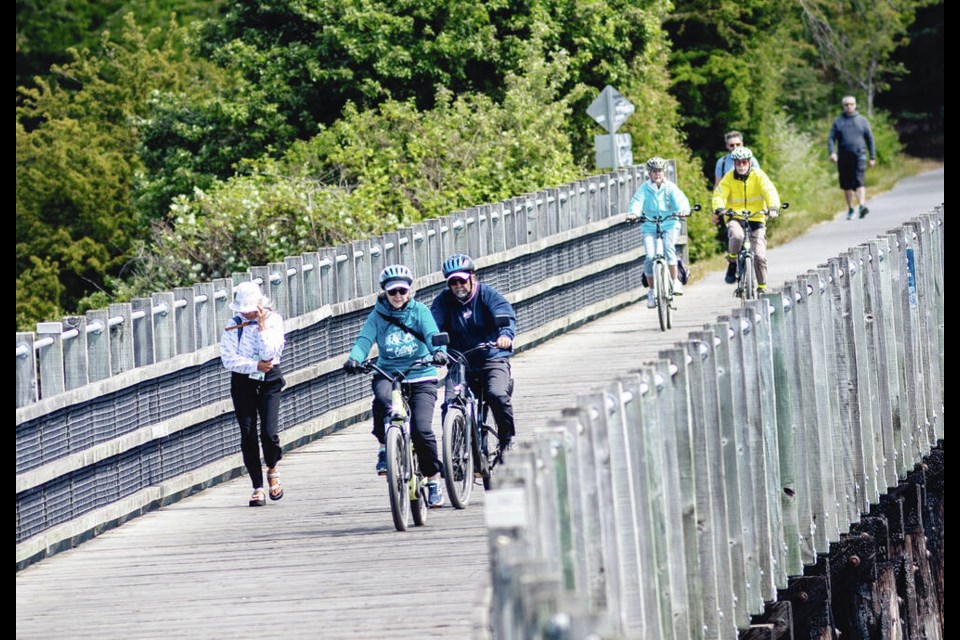Plans for separate cycling and pedestrian paths on the busiest and narrowest part of the Galloping Goose trail could make a comeback this July.
The idea of widening and lighting the trail was proposed in 2021, but despite strong public interest in the project, implementation stalled due to lack of grant funding, said Capital Regional District board chair Colin Plant. “All of the work on the regional trails to date has been done from grants,” Plant said. “It’s kind of hard to believe, because I think we all take it for granted.”
Now, however, CRD staff are expected to report in July on the possibility of a tax levy to fund the project, as well as other improvements to CRD-owned cycling infrastructure.
Currently, no taxes are collected for upgrading or expanding CRD regional trails.
“Even the idea of lighting the trail to improve safety and visibility for people, we’re currently at the behest of governments that grant to us,” Plant said.
The CRD has identified 6.6 kilometres of trail north of the Selkirk Trestle going past Uptown that would benefit from path widening and lighting, but upgrading those sections could cost up to $14 million, according to a 2020 estimate — money that would have to be cut from somewhere else in the budget.
Conversion of the Galloping Goose from a railway line to a multi-use trail began in 1987, while the Lochside regional trail was added in 2001. Decades later, the trails are due for an upgrade, said Corey Burger of Capital Bike, a cycling advocacy group. On older sections of the Galloping Goose, parallel dirt paths have sprung up to accommodate the increased traffic.
A proposal for a 6.5-metre separated bike and pedestrian pathway on priority sections of the Galloping Goose and Lochside regional trail network came to the CRD board in 2021, based on increasing numbers of trail users, the speed difference between cyclists and pedestrians, and the greater popularity of e-bikes.
Sales of e-bikes — which tend to be heavier and faster than conventional bicycles — have soared in North America in recent years.
Website servers for B.C.’s newly announced e-bike rebate were briefly overwhelmed Thursday when the site received more than 1,600 submissions in the first 30 minutes, according to the Ministry of Transportation.
Burger says the widening and lighting project is one of the top-needed cycling upgrades in the capital region.
Yet none of the $11 million from the active transportation fund announced for Vancouver Island last month went to the CRD.
Instead, the majority of the money is going to the creation of new protected bike lanes on Tillicum Road, Fort Street, and Shelbourne Street, with $7.4 million earmarked for projects in Victoria, Saanich, Esquimalt and UVic.
“There’s lots of roads in the region that need improvement, but the trail is bouncing into the point where it’s so busy, it’s starting to deter people from walking and biking,” Burger said. “We’re one of the few places in North America that has trails that are busy enough that need to be separated.
“In some ways, the CRD is trailblazing because there isn’t a nice pattern for them to follow that they could say: ‘This is what they’ve done elsewhere, so this is what we can do here.’ ”
Burger said a dedicated CRD tax to pay for trail improvements is “absolutely necessary.”
It’s not the first regional trail project that has been delayed by grant challenges, he said. The widening project has been identified as a priority for several years, as was the completion of the E&N Rail Trail.
Both were heavily delayed because of lack of grants, and eventually the CRD borrowed money to complete the E&N Rail Trail.
On Wednesday, more than 5,000 bike rides were recorded at a trip counter on the north end of the Selkirk trestle. Traffic volume on a much-wider secondary arterial road in Victoria ranges from 5,000 to 20,000 vehicles a day.
Around half of a 1.6-kilometre Galloping Goose section between Selkirk Trestle and Culduthel road is less than four metres wide, according to the CRD report.
The CRD has “big, bold visions” for increasing the number of people on bikes and tackling climate change, but has yet to prepare for future capacity growth on its regional trails, Burger said.
“What kind of numbers [are] you looking at the Goose in 20 years? What does that look like, in terms of building it now?”
As for now, widening the path can cut down on potential injuries in the event of a collision.
“There can be conflict between cyclists and pedestrians,” Plant said of the trail’s narrower sections. “And if it were just a bit wider, we’d all feel a little bit more comfortable.”
>>> To comment on this article, write a letter to the editor: [email protected]



